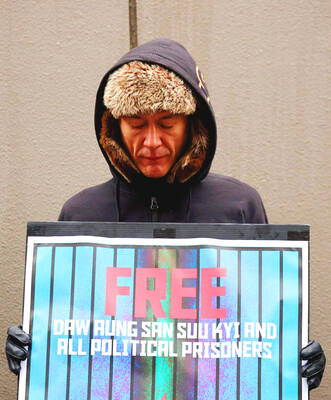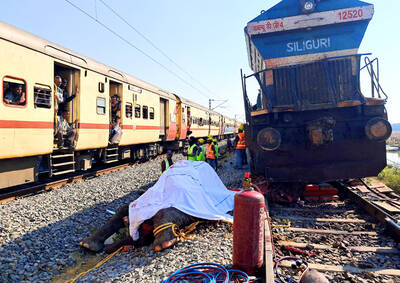Hundreds of protesters gathered outside the Japanese prime minister’s office on Friday, chanting slogans against the planned restart of reactors a year after the world’s worst nuclear disaster in 25 years.
“We oppose restarts,” the crowd of about 1,000 shouted in the peaceful demonstration.
Public mistrust of nuclear power has grown since the earthquake and tsunami on March 11 last year triggered the worst nuclear disaster since Chernobyl.
All of Japan’s nuclear power plants, which once supplied about 30 percent of the country’s energy needs, have been taken offline.
Japanese Prime Minister Yoshihiko Noda said on Wednesday that it is necessary to restart idled reactors to prevent energy shortages.
A group of regional governors, long concerned about safety at the Kansai Electric Power Co’s two reactors in Ohi, western Japan, signaled their agreement to the restarts as a “limited” step.
Feeding anti-nuclear sentiment was an announcement by Japanese nuclear industry officials, who said they hoped to start producing a half-tonne of plutonium within months, in addition to the more than 35 tonnes Japan already has stored around the world. This is in spite of all the reactors being either inoperable or offline at the moment.
“It’s crazy,” said Princeton University professor Frank von Hippel, a leading authority on nonproliferation issues. “There is absolutely no reason to do that.”
Japan’s nuclear industry produces plutonium — which is strictly regulated globally because it is also used for nuclear weapons — by reprocessing spent, uranium-based fuel in a procedure aimed at decreasing radioactive waste that otherwise would require long-term storage.
The industry wants to reprocess more to build up reserves in anticipation of when it has a network of reactors that run on a next-generation fuel that includes plutonium.
Japanese officials argue that, once those plans are in place, the reactors will draw down the stockpile and use up most of it by 2030.
“There is no excess plutonium in this country,” said Koichi Imafuku, an official at the Agency for Natural Resources and Energy. “It’s not just lying around without purpose.”
Other countries have scaled back the separation of plutonium because it is a proliferation concern and is more expensive than other alternatives, including long-term storage of spent fuel.
Von Hippel stressed that only two other countries reprocess on a large scale: France and the UK, and the latter has decided to stop. Japan’s civilian-use plutonium stockpile is already the fifth-largest in the world, and it has enough plutonium to make about 5,000 simple nuclear warheads.
Government regulations require industry representatives to announce by March 31 how much plutonium they intend to produce in the year ahead and explain how they will use it. However, for the second consecutive year, the industry has failed to do so.
Kimitake Yoshida, a spokesman for the Federation of Electric Power Companies, said the plutonium would be converted into MOX — a mixture of plutonium and uranium — which can be loaded back into reactors and reused in a cycle. However, technical glitches, cost overruns and local opposition have kept Japan from actually putting the moving parts of that plan into action.
Meanwhile, Japan’s plutonium stockpile has increased fivefold from about 7 tonnes in 1993 to 37 tonnes at the end of 2010. Japan initially said the stockpile would shrink rapidly in early 2000s as its fuel cycle kicked in, but that has not happened.
Critics argue that since no additional spent fuel is being created, this is not a good time start producing more. They also say it makes no sense for Japan to minimize its plutonium glut by calling it a “stockpile” rather than a “surplus.”
Officials stress that Japan files a yearly report detailing its stockpile with the International Atomic Energy Agency. However, it has repeatedly failed to keep to its own schedules for using the plutonium.
In 2006, the nuclear industry said the plutonium-consuming MOX fuel would be used in 16 to 18 conventional reactors “in or after” 2010. In fact, only two reactors used MOX that year. By last year, the number was still just three — including one at the Fukushima plant.
In response to the delays, the industry has simply lengthened its deadlines. It is now shooting for the end of fiscal 2015.
“There really is a credibility problem here,” Von Hippel said. “They keep making up these schedules which are never realized.”

The Burmese junta has said that detained former leader Aung San Suu Kyi is “in good health,” a day after her son said he has received little information about the 80-year-old’s condition and fears she could die without him knowing. In an interview in Tokyo earlier this week, Kim Aris said he had not heard from his mother in years and believes she is being held incommunicado in the capital, Naypyidaw. Aung San Suu Kyi, a Nobel Peace Prize laureate, was detained after a 2021 military coup that ousted her elected civilian government and sparked a civil war. She is serving a

REVENGE: Trump said he had the support of the Syrian government for the strikes, which took place in response to an Islamic State attack on US soldiers last week The US launched large-scale airstrikes on more than 70 targets across Syria, the Pentagon said on Friday, fulfilling US President Donald Trump’s vow to strike back after the killing of two US soldiers. “This is not the beginning of a war — it is a declaration of vengeance,” US Secretary of Defense Pete Hegseth wrote on social media. “Today, we hunted and we killed our enemies. Lots of them. And we will continue.” The US Central Command said that fighter jets, attack helicopters and artillery targeted ISIS infrastructure and weapon sites. “All terrorists who are evil enough to attack Americans are hereby warned

Seven wild Asiatic elephants were killed and a calf was injured when a high-speed passenger train collided with a herd crossing the tracks in India’s northeastern state of Assam early yesterday, local authorities said. The train driver spotted the herd of about 100 elephants and used the emergency brakes, but the train still hit some of the animals, Indian Railways spokesman Kapinjal Kishore Sharma told reporters. Five train coaches and the engine derailed following the impact, but there were no human casualties, Sharma said. Veterinarians carried out autopsies on the dead elephants, which were to be buried later in the day. The accident site

‘EAST SHIELD’: State-run Belma said it would produce up to 6 million mines to lay along Poland’s 800km eastern border, and sell excess to nations bordering Russia and Belarus Poland has decided to start producing anti-personnel mines for the first time since the Cold War, and plans to deploy them along its eastern border and might export them to Ukraine, the deputy defense minister said. Joining a broader regional shift that has seen almost all European countries bordering Russia, with the exception of Norway, announce plans to quit the global treaty banning such weapons, Poland wants to use anti-personnel mines to beef up its borders with Belarus and Russia. “We are interested in large quantities as soon as possible,” Deputy Minister of National Defense Pawel Zalewski said. The mines would be part